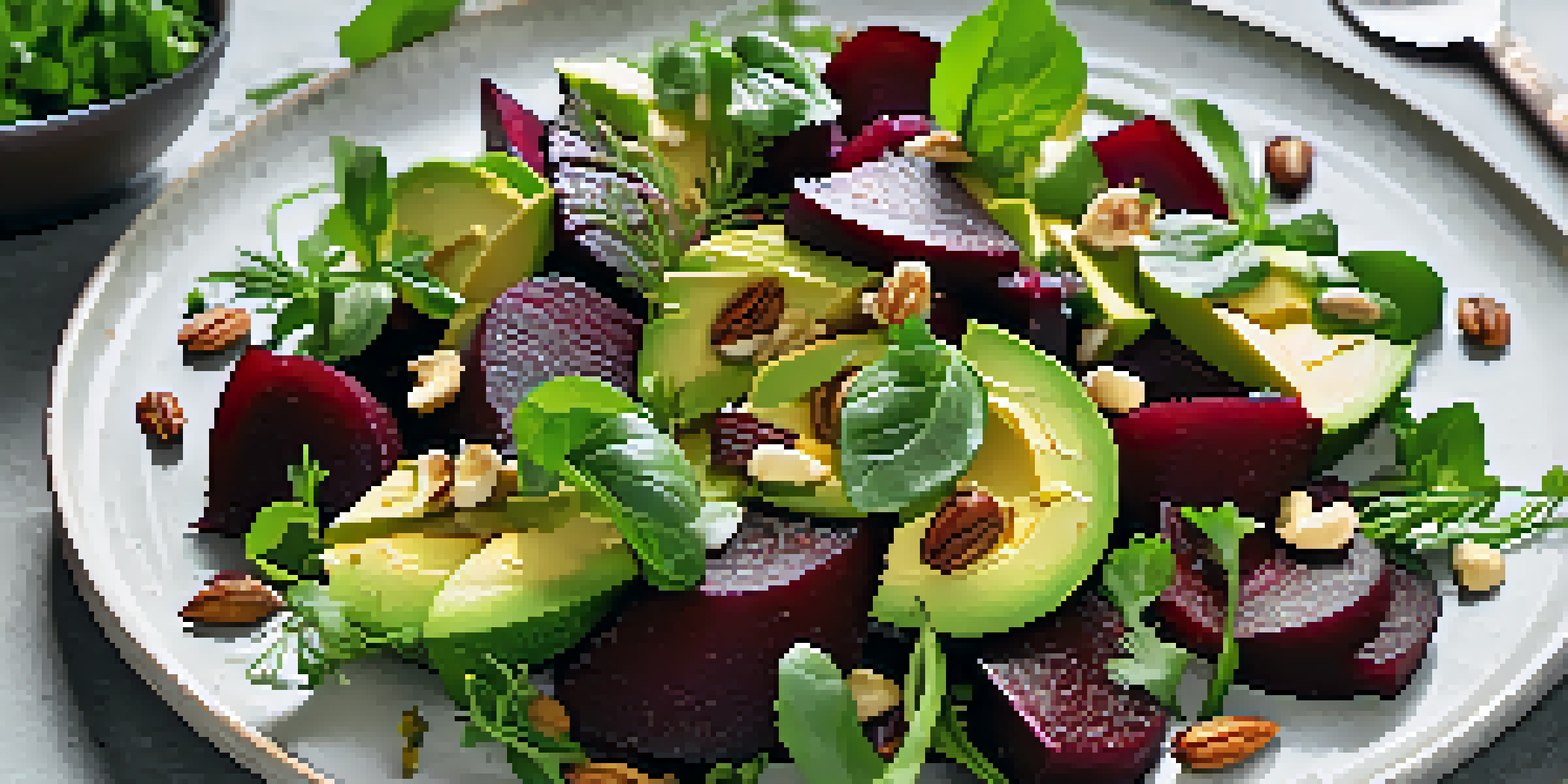Balancing Sweetness and Savory in Vegan Cuisine Creations

Understanding the Sweet and Savory Flavor Profiles
When we talk about flavors, sweetness and savory are like two sides of the same coin. Sweetness often comes from fruits, syrups, or sweet vegetables like carrots and beets, while savory flavors can be derived from herbs, spices, and umami-rich ingredients like mushrooms or soy sauce. Balancing these can elevate your vegan dishes, creating a harmonious taste experience.
Cooking is like love. It should be entered into with abandon or not at all.
Think of your favorite comfort foods; they often have a mix of sweet and savory elements. For instance, consider the classic pairing of roasted sweet potatoes drizzled with maple syrup and sprinkled with sea salt. This blend not only tantalizes your taste buds but also creates a satisfying depth that keeps you coming back for more.
In vegan cuisine, understanding how to blend these profiles is essential. It’s about finding that perfect equilibrium where one flavor enhances the other, rather than overpowering it. The goal is to create dishes that sing with complex flavors, inviting everyone to enjoy the goodness of plant-based eating.
Key Ingredients for Sweet and Savory Combinations
Certain ingredients lend themselves beautifully to balancing sweetness and savory notes. For instance, ingredients like balsamic vinegar or tamari can add a rich, savory depth while complementing the sweetness of fruits. Similarly, adding a pinch of cinnamon or nutmeg can enhance the sweetness of savory dishes like stews and roasted vegetables.

Nuts and seeds also play a crucial role in achieving this balance. Their inherent flavors can range from sweet to nutty, providing texture and crunch. Try adding toasted pecans to a salad with sliced apples; the nutty flavor pairs wonderfully with the sweetness of the fruit, creating a tasty contrast.
Balancing Sweet and Savory Flavors
Combining sweet and savory elements in vegan dishes enhances flavor complexity and creates a harmonious dining experience.
Don't forget about herbs and spices, which can transform the flavor profile of your dishes. Fresh herbs like basil or mint can add a refreshing touch to sweet dishes, while spices like cumin or smoked paprika can deepen the savory elements. Experimenting with these ingredients can lead to delightful discoveries in your vegan cooking adventures.
Experimenting with Fruit in Savory Dishes
Fruit is one of the most versatile ingredients in vegan cooking, and it can add a delightful sweetness to savory dishes. For example, adding diced mango or pineapple to a spicy salsa can create a refreshing flavor burst that balances heat with sweetness. This contrast is not only delicious but also visually appealing.
Food is not just what you eat. It's how you feel when you're eating it.
Consider using fruits in unexpected ways, like incorporating apples into a savory cabbage slaw or using figs in a grain salad. These combinations can surprise your palate and make your meals more exciting. Plus, the natural sweetness of fruits can help reduce the need for added sugars in your cooking.
When using fruit, think about complementary flavors. For instance, pairing roasted butternut squash with a drizzle of honey or agave syrup can create a delectable side dish. Adding a sprinkle of salt enhances the sweetness, bringing out the best in both flavor profiles for a balanced dish.
Incorporating Sweeteners Wisely in Savory Recipes
Sweeteners can be a powerful tool in vegan cuisine, but it's important to use them wisely. Natural sweeteners like maple syrup, agave nectar, or coconut sugar can enhance savory dishes without overwhelming them. A little drizzle can transform a simple dressing or marinade into something extraordinary.
For instance, a balsamic glaze made with reducing balsamic vinegar and a touch of maple syrup can beautifully glaze roasted Brussels sprouts, adding complexity to the dish. This kind of balance can elevate your cooking, inviting guests to savor every bite without feeling like they’re indulging too much.
Utilizing Textures for Flavor Depth
Incorporating various textures, such as creamy, crunchy, and chewy components, can elevate the overall flavor experience of a dish.
However, moderation is key. Overdoing sweeteners can lead to an unbalanced dish, so always taste as you go. A good rule of thumb is to start with a small amount and adjust based on your preference, ensuring that the sweetness complements the savory rather than taking center stage.
Creating Savory Desserts with a Twist
Savory desserts might sound unconventional, but they can be a delightful surprise. For example, think about a sweet potato pie that balances the natural sweetness of the sweet potato with spices like nutmeg and a hint of salt. This combination can create a dessert that feels both comforting and sophisticated.
Another great example is using herbs like rosemary or thyme in baked goods. A rosemary-infused lemon cake or thyme-spiced cookies can add an unexpected savory note that complements the sweetness beautifully. These unique flavor profiles can intrigue your guests and offer a memorable dining experience.
When venturing into savory desserts, don't shy away from experimenting. Infusing your recipes with herbs and spices can lead to extraordinary results. The key is to find that sweet spot where the savory elements enhance the overall dessert experience, keeping it exciting and refreshing.
Balancing Textures for Enhanced Flavor Experience
Texture plays a crucial role in how we perceive flavors. A dish that combines creamy, crunchy, and chewy elements can create a delightful eating experience. Think about a grain bowl topped with creamy avocado, crunchy nuts, and sweet roasted vegetables; this combination not only pleases the palate but also the senses.
To achieve this balance, consider incorporating various textures into your dishes. For instance, adding a sprinkle of toasted seeds or nuts on top of a sweet and savory salad can provide a satisfying crunch that enhances the overall flavor profile. This contrast can make a simple dish feel gourmet.
Creative Presentation Matters
Thoughtful presentation of vegan dishes not only makes them visually appealing but also enhances the anticipation of the flavors to come.
Furthermore, the way we prepare ingredients can affect texture. Roasting vegetables can caramelize their natural sugars, intensifying sweetness while adding a crispy exterior. On the other hand, fresh herbs can add a burst of freshness to a dish. By playing with textures, you can create a multi-dimensional flavor experience that keeps every bite interesting.
The Art of Presentation in Vegan Cuisine
Presentation is crucial in making dishes appealing, especially when balancing sweet and savory elements. The way you plate your food can enhance its visual appeal and set the stage for the flavors to come. A colorful arrangement can make even the simplest meals feel special and inviting.
Consider using contrasting colors and shapes when plating your dishes. A vibrant salad with sweet beets, creamy avocado, and crunchy nuts not only looks beautiful but also highlights the different flavors and textures in the dish. This visual variety can entice diners and encourage them to dig in.

Don't forget about garnishes! A sprinkle of fresh herbs or a drizzle of balsamic reduction can add a pop of color and a final touch of flavor. Thoughtful presentation not only elevates your dishes but also shows that you value the dining experience, making it all the more enjoyable.